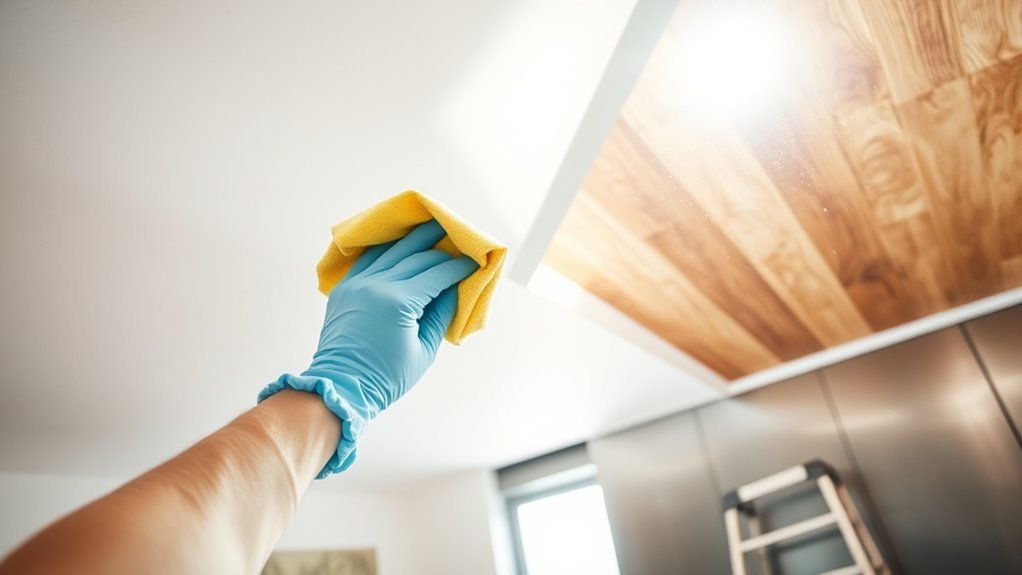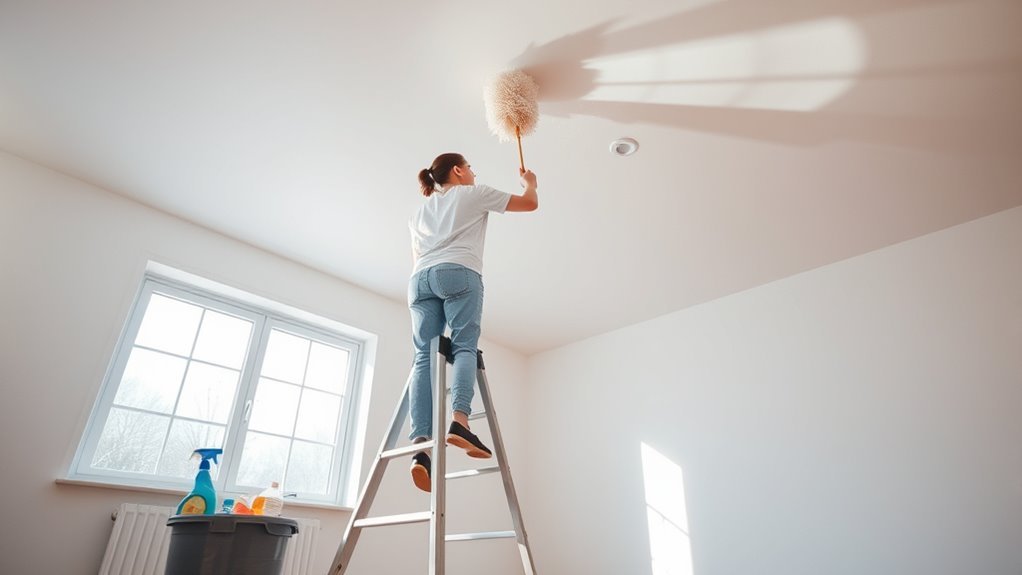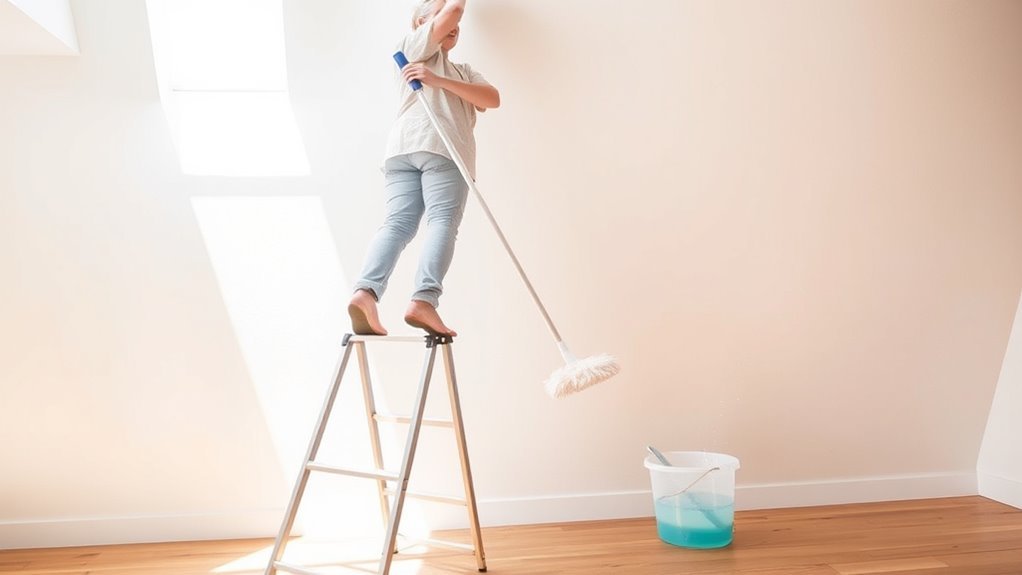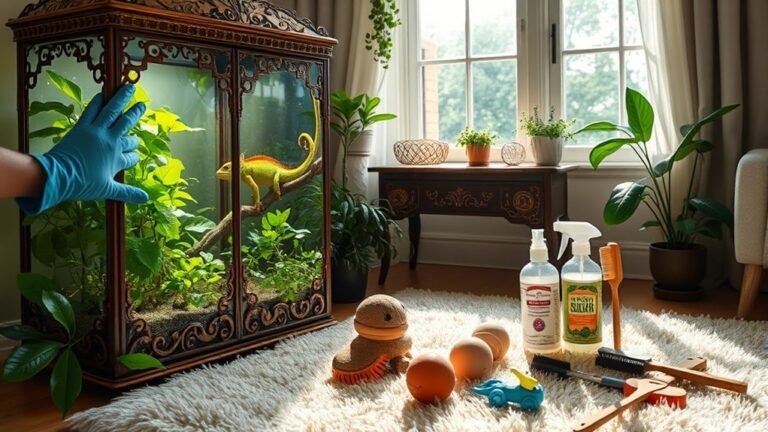Cleaning Techniques for Ceilings Owners
When cleaning your ceiling, first identify the material—acoustic tiles need gentle, moisture-limited care; painted or textured ceilings require non-abrasive tools. Use an extendable duster or microfiber cloth to safely remove dust, working methodically from corner to corner. For stains, apply mild detergent sparingly and test stronger solutions on a small patch. Prevent damage by regularly inspecting and controlling humidity. Following precise steps guarantees your ceiling stays clean and intact, with further insights available on maintaining different ceiling types effectively.
Understanding Different Ceiling Materials

Before diving into specific cleaning methods, it’s important to recognize that ceilings come in various materials, each requiring distinct care. If your ceiling features acoustic tiles, you’ll need a gentle approach to avoid damaging their porous surface, which can trap dust and dirt. Avoid excessive moisture, as it may cause warping or mold growth. For ceilings with traditional or textured ceiling paint, cleaning requires non-abrasive techniques to prevent paint peeling or discoloration. Use soft tools and mild cleaners compatible with painted surfaces. Knowing the exact ceiling material helps you select the appropriate cleaning strategy, ensuring longevity and aesthetic integrity. By understanding whether you’re dealing with acoustic tiles or a ceiling paint finish, you maintain freedom to clean effectively without risking costly damage or compromising your ceiling’s functionality.
Essential Tools and Cleaning Supplies
Five essential tools and cleaning supplies form the foundation of effective ceiling maintenance. To maintain your ceilings, you’ll rely on specific cleaning gadgets and eco friendly solutions that guarantee thoroughness without damage.
| Tool/Supply | Purpose |
|---|---|
| Extendable Duster | Reaches high ceilings safely |
| Microfiber Cloths | Traps dust without scratching |
| Eco Friendly Cleaner | Removes stains without harsh chemicals |
| Soft Brush | Gently cleans textured surfaces |
| Ladder | Provides stable access to ceilings |
Choosing the right cleaning gadgets supports sustainability and effectiveness. Eco friendly solutions prevent residue build-up and preserve ceiling integrity. Proper use of these supplies grants you the freedom to maintain your ceilings efficiently, preserving their appearance and durability over time.
Step-by-Step Dust Removal Methods

Effective dust removal from ceilings involves a systematic approach to confirm all surfaces are thoroughly cleaned without causing damage. Start by evaluating the ceiling type to select appropriate dusting techniques such as microfiber dusters or electrostatic cloths, which efficiently capture particles without abrasion. Use an extendable pole to reach high areas safely. Begin at one corner, moving methodically across the surface to guarantee no spots are missed. Maintain consistent pressure to avoid surface damage. Adhering to a regular cleaning frequency, ideally every three to six months, prevents dust accumulation and preserves ceiling integrity. For textured ceilings, gently brush to avoid dislodging material. Following these precise steps grants you control over dust removal, confirming a clean ceiling environment while maintaining your freedom from frequent, labor-intensive cleanings.
Tackling Stains and Discoloration
Once you’ve removed dust thoroughly, addressing stains and discoloration is the next step to restoring your ceiling’s appearance. Start by identifying discoloration causes—common ones include water damage, smoke exposure, and mold growth. For effective stain removal, use a mild detergent solution or a specialized ceiling cleaner applied with a soft sponge. Avoid excessive moisture, which can worsen stains or cause structural damage. For persistent stains, a diluted bleach solution can target mold or mildew, but test it on a small area first. Always wear protective gear when handling chemicals. After cleaning, allow the ceiling to dry completely. Understanding these technical aspects helps you regain freedom from unsightly blemishes while preserving your ceiling’s integrity efficiently and safely.
Preventative Measures to Keep Ceilings Clean

Although cleaning stains is essential, implementing preventative measures can greatly reduce the frequency and intensity of ceiling maintenance. You should establish routine inspections to identify early signs of damage or dirt accumulation. This proactive approach helps you address minor issues before they escalate, preserving the ceiling’s integrity and appearance. Controlling indoor humidity and ensuring proper ventilation minimizes mold and mildew growth, which often cause stubborn stains. Using washable or moisture-resistant paint can further streamline cleaning efforts. Additionally, avoid smoking indoors and limit the use of aerosols near ceilings, as airborne particles contribute to discoloration. By consistently applying these preventative strategies, you maintain a cleaner ceiling surface, reduce the need for aggressive cleaning, and extend the lifespan of your ceiling materials, granting you more freedom from frequent, intensive maintenance.
Frequently Asked Questions
How Often Should Professional Ceiling Cleaning Be Scheduled?
You should follow frequency guidelines to determine the perfect cleaning intervals for your ceiling. Typically, professional ceiling cleaning is recommended every 2 to 3 years, but this depends on factors like environment, usage, and material type. If you’re in a high-traffic or humid area, more frequent cleaning might be necessary. By adhering to these intervals, you guarantee your ceiling remains in peak condition while giving you the freedom to focus on other priorities.
Are There Eco-Friendly Cleaning Products Safe for All Ceiling Types?
Yes, you can definitely use biodegradable cleaners and natural alternatives that are safe for all ceiling types. These eco-friendly products break down quickly without harming the environment and avoid harsh chemicals that could damage delicate surfaces. When selecting a cleaner, check labels for non-toxic ingredients and suitability for your specific ceiling material. By choosing these options, you maintain your ceiling’s integrity while supporting a healthier, sustainable environment effortlessly.
Can Ceiling Cleaning Improve Indoor Air Quality?
Yes, cleaning ceiling dust can considerably improve indoor air quality by reducing airborne particles that often circulate through your home’s air circulation system. When dust accumulates on ceilings, it can become a source of allergens and pollutants. By regularly removing ceiling dust, you minimize these contaminants, allowing your air circulation to function more efficiently and deliver cleaner air. This helps you maintain a healthier and more comfortable living environment.
What Are the Risks of Using Pressure Washers on Ceilings?
Imagine using a pressure washer like a medieval knight wielding a mighty sword—powerful but risky. When you use a pressure washer on ceilings, you risk pressure washer damage, such as cracking or stripping paint and weakening drywall. Excess moisture can also lead to mold growth risks, threatening your indoor air quality and freedom from health issues. It’s essential to balance cleaning power with care to protect your ceiling’s integrity and your well-being.
How to Safely Clean Ceilings With Electrical Fixtures?
When cleaning ceilings with electrical fixtures, you need to prioritize safety precautions first. Turn off the power supply to avoid shocks. Identify your ceiling materials—drywall, plaster, or wood—to choose suitable cleaning methods. Avoid excessive moisture near fixtures; use a damp cloth instead of spray cleaners. Use insulated tools and guarantee your ladder is stable. By following these steps, you maintain both your freedom to clean effectively and your safety around electrical components.






